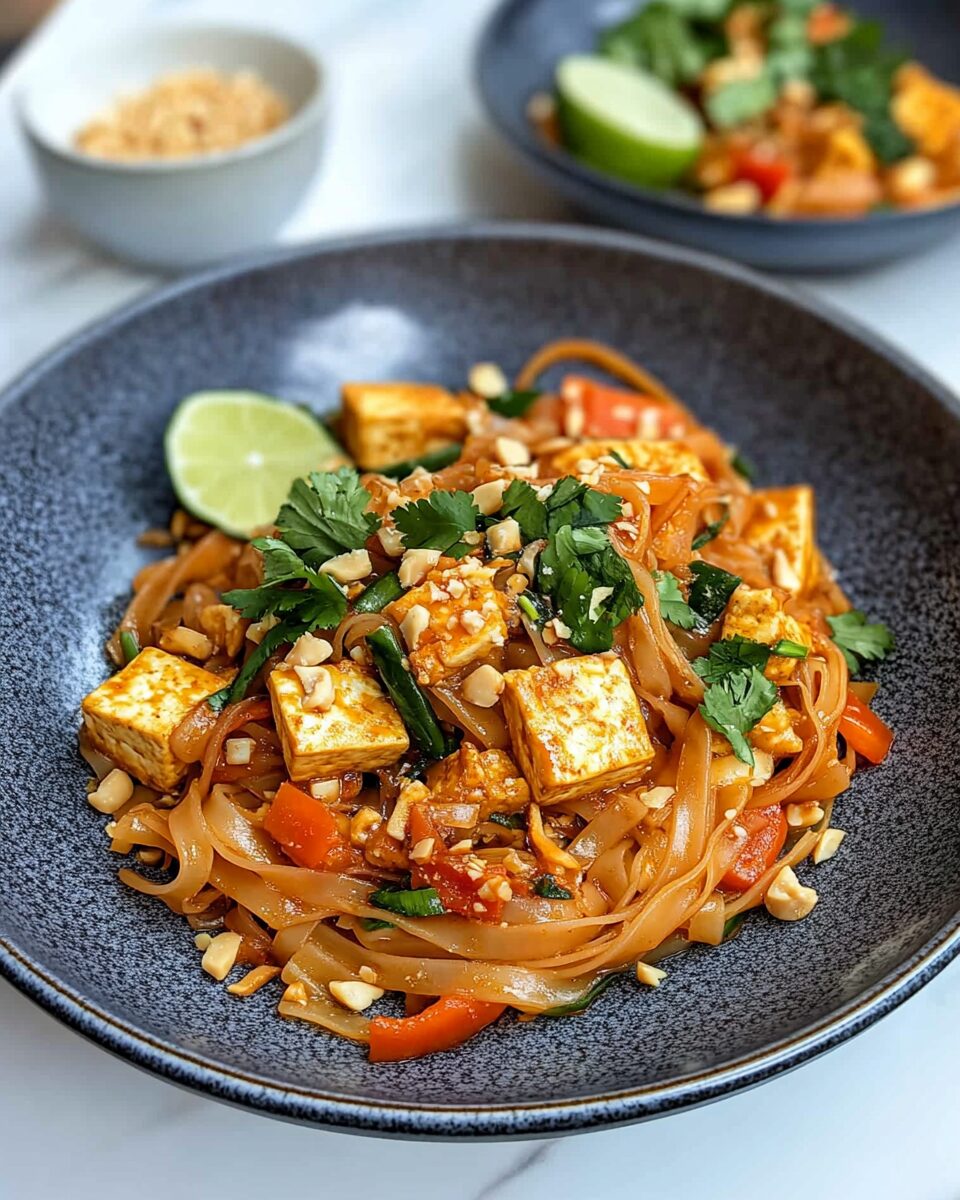The symphony of sweet, sour, salty, and spicy in this Vegetarian Pad Thai with Tofu makes it one of Thailand’s most iconic dishes and one you can now easily recreate at home. With chewy rice noodles, crispy tofu cubes, fresh vegetables, and a zesty tamarind-based sauce, every bite is a beautiful harmony of texture and flavor. This version is flexible for all dietary needs and can be made fully vegan and gluten-free. It’s the perfect quick dinner for busy weeknights or a flavorful centerpiece for a casual gathering. Ready in just 30 minutes, it delivers a takeout-worthy experience straight from your kitchen wok.
Full Recipe:
Ingredients:
-
200g flat rice noodles
-
200g firm tofu, cubed
-
1 tablespoon cornstarch
-
2 tablespoons vegetable oil
-
2 cloves garlic, minced
-
2 eggs (optional, omit for vegan)
-
1 red bell pepper, thinly sliced
-
2 carrots, julienned
-
3 spring onions, chopped
-
100g bean sprouts
-
1/4 cup roasted peanuts, crushed
-
1 lime, cut into wedges
-
Fresh cilantro, for garnish
Pad Thai Sauce:
-
3 tablespoons tamarind paste
-
3 tablespoons soy sauce (or tamari for gluten-free)
-
1 tablespoon brown sugar
-
1 teaspoon chili flakes (adjust to taste)
Directions:
-
Cook rice noodles according to package instructions. Drain and set aside.
-
Pat tofu dry and toss in cornstarch. Heat 1 tbsp oil in a large pan or wok, then fry tofu until golden and crispy. Set aside.
-
In the same pan, add remaining oil and sauté garlic until fragrant.
-
If using eggs, crack them into the pan, scramble lightly and cook until set.
-
Add bell pepper, carrots, and half of the spring onions. Stir-fry for 2-3 minutes.
-
Add noodles, tofu, and the sauce. Toss everything together until well combined and heated through.
-
Stir in bean sprouts just before turning off the heat to keep them crunchy.
-
Serve hot, topped with peanuts, remaining spring onions, fresh cilantro, and lime wedges.
Prep Time: 15 minutes | Cooking Time: 15 minutes | Total Time: 30 minutes
Kcal: 470 kcal | Servings: 4 servings
A Flavorful Thai Classic Made Plant-Based
Thai cuisine is a symphony of bold flavors sweet, salty, tangy, and spicy delivered through artful combinations of fresh herbs, fermented ingredients, and quick, high-heat cooking methods. Among its most beloved dishes, Pad Thai stands out not only as Thailand’s national street food treasure but also as one of the most popular Asian dishes worldwide. Traditionally made with stir-fried rice noodles, eggs, tofu or shrimp, and a tangy tamarind sauce, this dish offers a comforting yet exciting culinary experience.
Today, we’re exploring a delicious plant-based spin on this classic: Vegetarian Pad Thai with Tofu. With no meat and the option to make it fully vegan, this dish retains every bit of its vibrant character while aligning with modern health-conscious and ethical eating habits.
The Origins and Rise of Pad Thai
Pad Thai, or “Phat Thai” as it’s called in Thailand, actually has a relatively recent history. Unlike other ancient recipes passed down through generations, Pad Thai rose to prominence in the 1930s during a period of Thai nationalism. As part of a campaign led by then-Prime Minister Plaek Phibunsongkhram to establish a national identity and promote rice noodle consumption (to reduce reliance on foreign imports), Pad Thai was introduced as a patriotic dish.
Vendors across the country were encouraged to sell Pad Thai from food carts. It was affordable, easy to prepare, and loaded with local ingredients like tamarind, peanuts, and fish sauce. Soon, it became a staple in Thai households and a culinary icon on the global stage.
The modern vegetarian version maintains the original spirit but replaces fish sauce and shrimp with plant-based substitutes and tofu without compromising on depth of flavor.
Why Tofu Works Perfectly in Pad Thai
Tofu, a high-protein soy product, is not just a meat replacement it’s a culinary canvas. In Pad Thai, firm tofu is typically cubed and lightly fried until crispy on the outside, adding a satisfying bite and protein boost to the dish.
Its neutral taste absorbs the sweet and tangy Pad Thai sauce beautifully. Plus, tofu’s golden crust mimics the satisfying texture traditionally achieved with proteins like shrimp or chicken. For those following plant-based or vegetarian diets, tofu is a fantastic way to make the dish hearty and wholesome without relying on animal products.
Health Benefits of Vegetarian Pad Thai
This vegetarian adaptation is as nutritious as it is tasty. Here’s why:
1. Plant-Based Protein
Tofu offers all nine essential amino acids, making it a complete protein. When combined with rice noodles and peanuts, this dish delivers a powerful and satisfying protein punch—perfect for vegetarians and flexitarians alike.
2. Nutrient-Dense Vegetables
Ingredients like bean sprouts, bell peppers, carrots, and green onions add a wealth of vitamins, minerals, and fiber. These elements support digestion, boost immunity, and enhance skin health.
3. Heart-Healthy Fats
Crushed peanuts and cooking oils (when used mindfully) provide unsaturated fats, which are known to improve heart health and reduce inflammation.
4. Low in Added Sugars
Unlike many Westernized sauces that rely heavily on sugar or syrups, the tamarind-based sauce in Pad Thai has a natural tartness, requiring only a touch of sweetener. You can control how much sugar goes into your dish, or even replace it with coconut sugar or maple syrup for a more natural alternative.
Vegan and Gluten-Free Friendly
One of the best features of Vegetarian Pad Thai is how easily it can be adapted to fit various dietary needs:
-
To make it vegan: Omit the egg and use soy sauce or tamari instead of fish sauce. You can also explore vegan fish sauce alternatives made from seaweed or mushrooms.
-
To make it gluten-free: Simply use tamari or a gluten-free soy sauce and double-check that your rice noodles are gluten-free certified.
These small changes allow more people to enjoy this flavorful dish without restrictions or dietary concerns.
Customization Ideas
The beauty of Pad Thai lies in its flexibility. Once you understand the flavor balance and technique, you can customize it to your liking:
-
Spice Level: Adjust chili flakes or add fresh Thai chilies for extra heat.
-
Protein Options: Use tempeh, seitan, or even jackfruit for a different texture. You can also include edamame or chickpeas for more variety.
-
Vegetable Swaps: Add broccoli, snap peas, or zucchini to incorporate seasonal or leftover vegetables.
-
Noodle Alternatives: For a low-carb option, try spiralized zucchini noodles or shirataki noodles.
These ideas not only help prevent kitchen boredom but also reduce food waste.
Cooking Tips for the Best Homemade Pad Thai
Although Pad Thai is a quick-cooking dish, a few culinary tips will help you nail the perfect flavor and texture:
Advertisement
-
Use High Heat: Pad Thai is best when cooked quickly over high heat in a wok or large skillet. This helps sear the tofu and keeps vegetables crisp.
-
Prep Everything Before Cooking: This dish comes together in minutes, so have all your ingredients measured and ready to go before you begin.
-
Don’t Overcook the Noodles: Rice noodles should be slightly chewy and not mushy. Rinse them under cold water after boiling to stop the cooking process.
-
Balance the Sauce: Taste and adjust your sauce before adding it to the pan. Tamarind paste should be tangy, not overpowering. A perfect balance of sweet, sour, salty, and spicy is key.
Serving Suggestions
Vegetarian Pad Thai is a complete meal on its own, but a few accompaniments can enhance your dining experience:
-
Appetizers: Serve with Thai spring rolls, mango salad, or cucumber peanut salad.
-
Drinks: Thai iced tea or lemongrass ginger tea makes for a refreshing contrast.
-
Garnishes: Extra lime wedges, chopped cilantro, or crushed peanuts allow each diner to customize their own plate.
You can also pair it with a simple Thai soup like Tom Yum or a coconut milk-based curry for a full-course meal.
Conclusion:
Vegetarian Pad Thai with Tofu proves that going meatless doesn’t mean compromising flavor. This dish embodies everything we love about Thai cuisine bold spices, aromatic ingredients, and delightful textures while embracing plant-based principles that are better for the planet and your health.
Whether you’re a seasoned vegetarian, a curious flexitarian, or someone just trying to eat healthier a few nights a week, this recipe is a worthy addition to your culinary rotation. Its balance of umami, sweetness, and spice will keep you coming back for more. Plus, it’s fast, budget-friendly, and endlessly adaptable a true hero in the modern kitchen.

